Fluid Dynamic Assessment and Development of Nusselt Correlations for Fischer Koch S Structures
Abstract
:1. Introduction
2. Methodology
2.1. Generation of Fischer Koch S (FKS) Structures
2.2. CFD Modelling
2.3. Processing of Thermal and Flow-Related Characteristics
3. Results
3.1. Fluid flow Characteristics and Pressure Drops
3.2. Heat Transfer Coefficients and Nusselt Numbers
3.3. Correlation between Nusselt Numbers and Friction Factors
3.4. Assessment of Heat Transfer Performance
4. Conclusions
Author Contributions
Funding
Data Availability Statement
Conflicts of Interest
References
- Yeranee, K.; Rao, Y. A Review of Recent Investigations on Flow and Heat Transfer Enhancement in Cooling Channels Embedded with Triply Periodic Minimal Surfaces (TPMS). Energies 2022, 15, 8994. [Google Scholar] [CrossRef]
- Jin, Y.; Kong, H.; Zhou, X.; Li, G.; Du, J. Design and Characterization of Sheet-Based Gyroid Porous Structures with Bioinspired Functional Gradients. Materials 2020, 13, 3844. [Google Scholar] [CrossRef]
- Kaur, I.; Singh, P. Critical evaluation of additively manufactured metal lattices for viability in advanced heat exchangers. Int. J. Heat Mass Transf. 2021, 168, 120858. [Google Scholar] [CrossRef]
- Feng, J.; Fu, J.; Yao, X.; He, Y. Triply periodic minimal surface (TPMS) porous structures: From multi-scale design, precise additive manufacturing to multidisciplinary applications. Int. J. Extrem. Manuf. 2022, 4, 022001. [Google Scholar] [CrossRef]
- Ouda, M.; Al-Ketan, O.; Sreedhar, N.; Hasan Ali, M.I.; Abu Al-Rub, R.K.; Hong, S.; Arafat, H.A. Novel static mixers based on triply periodic minimal surface (TPMS) architectures. J. Environ. Chem. Eng. 2020, 8, 104289. [Google Scholar] [CrossRef]
- Kladovasilakis, N.; Tsongas, K.; Tzetzis, D. Mechanical and FEA-Assisted Characterization of Fused Filament Fabricated Triply Periodic Minimal Surface Structures. J. Compos. Sci. 2021, 5, 58. [Google Scholar] [CrossRef]
- Fan, X.; Tang, Q.; Feng, Q.; Ma, S.; Song, J.; Jin, M.; Guo, F.; Jin, P. Design, mechanical properties and energy absorption capability of graded-thickness triply periodic minimal surface structures fabricated by selective laser melting. Int. J. Mech. Sci. 2021, 204, 106586. [Google Scholar] [CrossRef]
- Pan, C.; Han, Y.; Lu, J. Design and Optimization of Lattice Structures: A Review. Appl. Sci. 2020, 10, 6374. [Google Scholar] [CrossRef]
- Crossland, E.J.W.; Kamperman, M.; Nedelcu, M.; Ducati, C.; Wiesner, U.; Smilgies, D.-M.; Toombes, G.E.S.; Hillmyer, M.A.; Ludwigs, S.; Steiner, U.; et al. A Bicontinuous Double Gyroid Hybrid Solar Cell. Nano Lett. 2009, 9, 2807–2812. [Google Scholar] [CrossRef]
- Elliott, O.; Gray, S.; McClay, M.; Nassief, B.; Nunnelley, A.; Vogt, E.; Ekong, J.; Kardel, K.; Khoshkhoo, A.; Proaño, G.; et al. Design and Manufacturing of High Surface Area 3D-Printed Media for Moving Bed Bioreactors for Wastewater Treatment. J. Contemp. Water Res. Educ. 2017, 160, 144–156. [Google Scholar] [CrossRef]
- Ataee, A.; Li, Y.; Fraser, D.; Song, G.; Wen, C. Anisotropic Ti-6Al-4V gyroid scaffolds manufactured by electron beam melting (EBM) for bone implant applications. Mater. Des. 2018, 137, 345–354. [Google Scholar] [CrossRef]
- Simon, U.; Dimartino, S. Direct 3D printing of monolithic ion exchange adsorbers. J. Chromatogr. A 2019, 1587, 119–128. [Google Scholar] [CrossRef] [PubMed]
- Niknam, S.A.; Mortazavi, M.; Li, D. Additively manufactured heat exchangers: A review on opportunities and challenges. Int. J. Adv. Manuf. Technol. 2020, 112, 601–618. [Google Scholar] [CrossRef]
- Li, W.; Yu, G.; Yu, Z. Bioinspired heat exchangers based on triply periodic minimal surfaces for supercritical CO2 cycles. Appl. Therm. Eng. 2020, 179, 115686. [Google Scholar] [CrossRef]
- Kaur, I.; Singh, P. State-of-the-art in heat exchanger additive manufacturing. Int. J. Heat Mass Transf. 2021, 178, 121600. [Google Scholar] [CrossRef]
- Iyer, J.; Moore, T.; Nguyen, D.; Roy, P.; Stolaroff, J. Heat transfer and pressure drop characteristics of heat exchangers based on triply periodic minimal and periodic nodal surfaces. Appl. Therm. Eng. 2022, 209, 118192. [Google Scholar] [CrossRef]
- Kim, J.; Yoo, D.-J. 3D printed compact heat exchangers with mathematically defined core structures. J. Comput. Des. Eng. 2020, 7, 527–550. [Google Scholar] [CrossRef]
- Kelly, J.P.; Finkenauer, L.R.; Roy, P.; Stolaroff, J.K.; Nguyen, D.T.; Ross, M.S.; Hoff, A.T.; Haslam, J.J. Binder jet additive manufacturing of ceramic heat exchangers for concentrating solar power applications with thermal energy storage in molten chlorides. Addit. Manuf. 2022, 56, 102937. [Google Scholar] [CrossRef]
- Abu-Khader, M.M. Plate heat exchangers: Recent advances. Renew. Sustain. Energy Rev. 2012, 16, 1883–1891. [Google Scholar] [CrossRef]
- Kumar, V.; Saini, S.; Sharma, M.; Nigam, K.D.P. Pressure drop and heat transfer study in tube-in-tube helical heat exchanger. Chem. Eng. Sci. 2006, 61, 4403–4416. [Google Scholar] [CrossRef]
- Sadeghianjahromi, A.; Wang, C.-C. Heat transfer enhancement in fin-and-tube heat exchangers—A review on different mechanisms. Renew. Sustain. Energy Rev. 2021, 137, 110470. [Google Scholar] [CrossRef]
- Sayed Ahmed, S.A.E.; Mesalhy, O.M.; Abdelatief, M.A. Flow and heat transfer enhancement in tube heat exchangers. Heat Mass Transf. 2015, 51, 1607–1630. [Google Scholar] [CrossRef]
- Yang, Y.; Li, Y.; Si, B.; Zheng, J. Performance Evaluation of Heat Transfer Enhancement for Offset Strip Fins Used in Plate-Fin Heat Exchangers. J. Heat Transf. 2015, 137, 101901. [Google Scholar] [CrossRef]
- Gherasim, I.; Taws, M.; Galanis, N.; Nguyen, C.T. Heat transfer and fluid flow in a plate heat exchanger part I. Experimental investigation. Int. J. Therm. Sci. 2011, 50, 1492–1498. [Google Scholar] [CrossRef]
- Saeed, M.; Kim, M.-H. Thermal and hydraulic performance of SCO2 PCHE with different fin configurations. Appl. Therm. Eng. 2017, 127, 975–985. [Google Scholar] [CrossRef]
- Cheng, Z.; Li, X.; Xu, R.; Jiang, P. Investigations on porous media customized by triply periodic minimal surface: Heat transfer correlations and strength performance. Int. Commun. Heat Mass Transf. 2021, 129, 105713. [Google Scholar] [CrossRef]
- Al-Ketan, O.; Abu Al-Rub, R.K. Multifunctional Mechanical Metamaterials Based on Triply Periodic Minimal Surface Lattices. Adv. Eng. Mater. 2019, 21, 1900524. [Google Scholar] [CrossRef]
- Shah, R.K.; Sekulic, D.P. Shah—Fundamentals of Heat Exchanger Design; John Wiley & Sons, Inc.: Hoboken, NJ, USA, 2003. [Google Scholar]
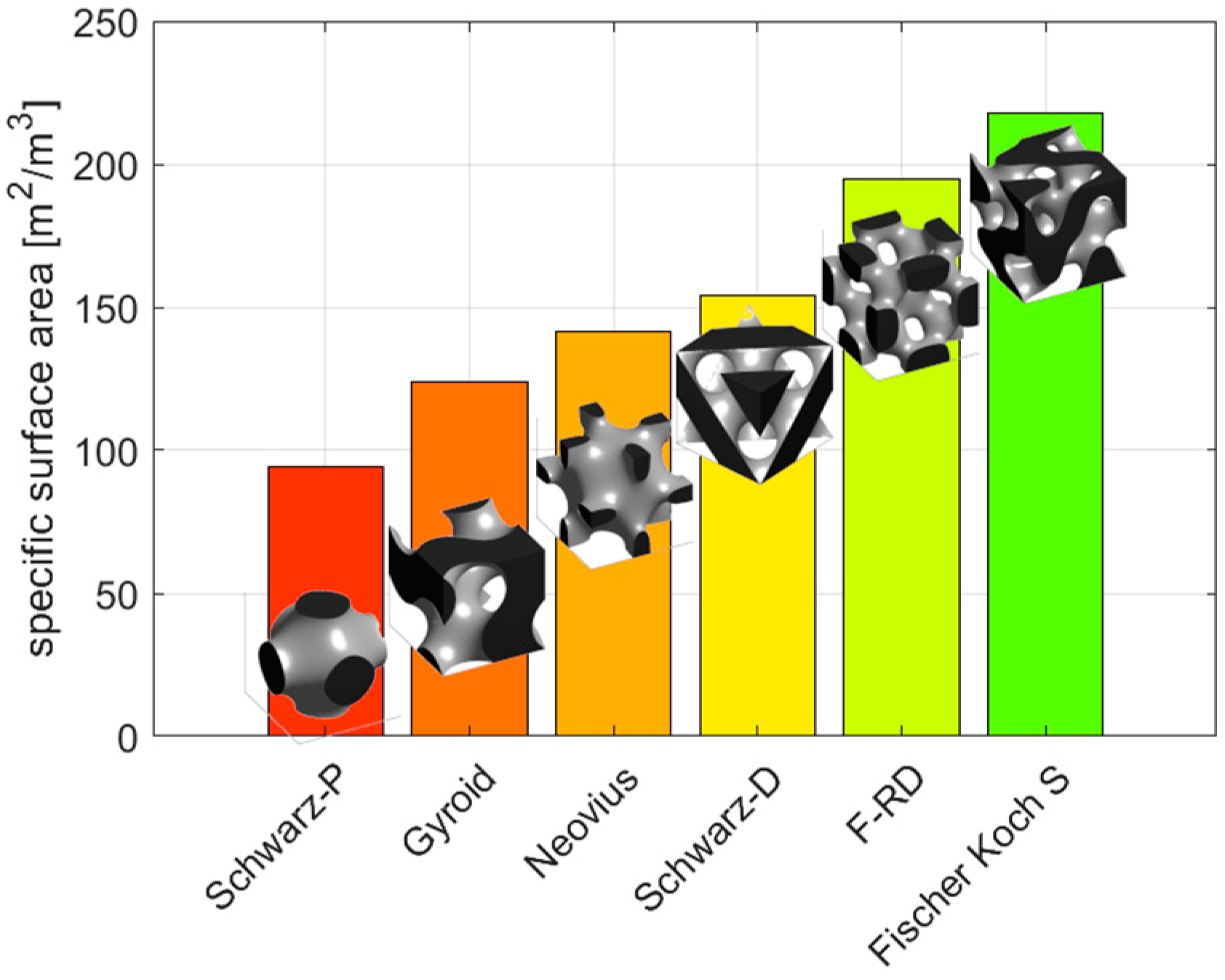






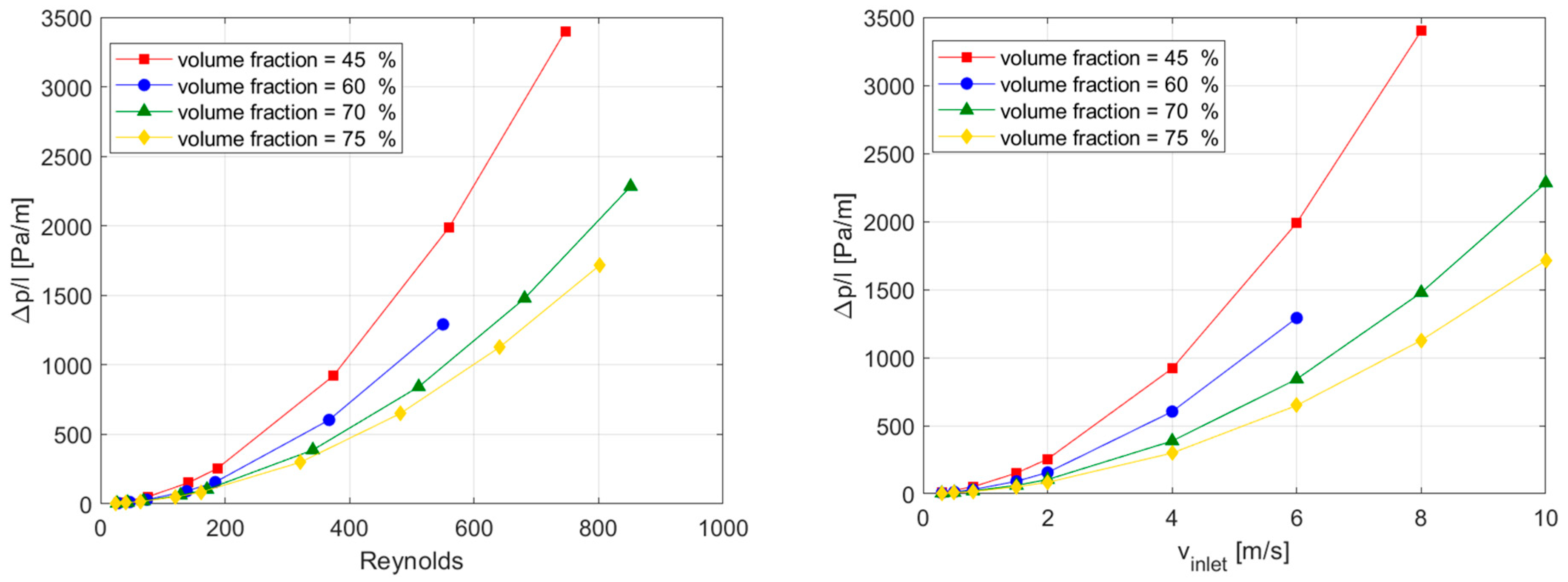

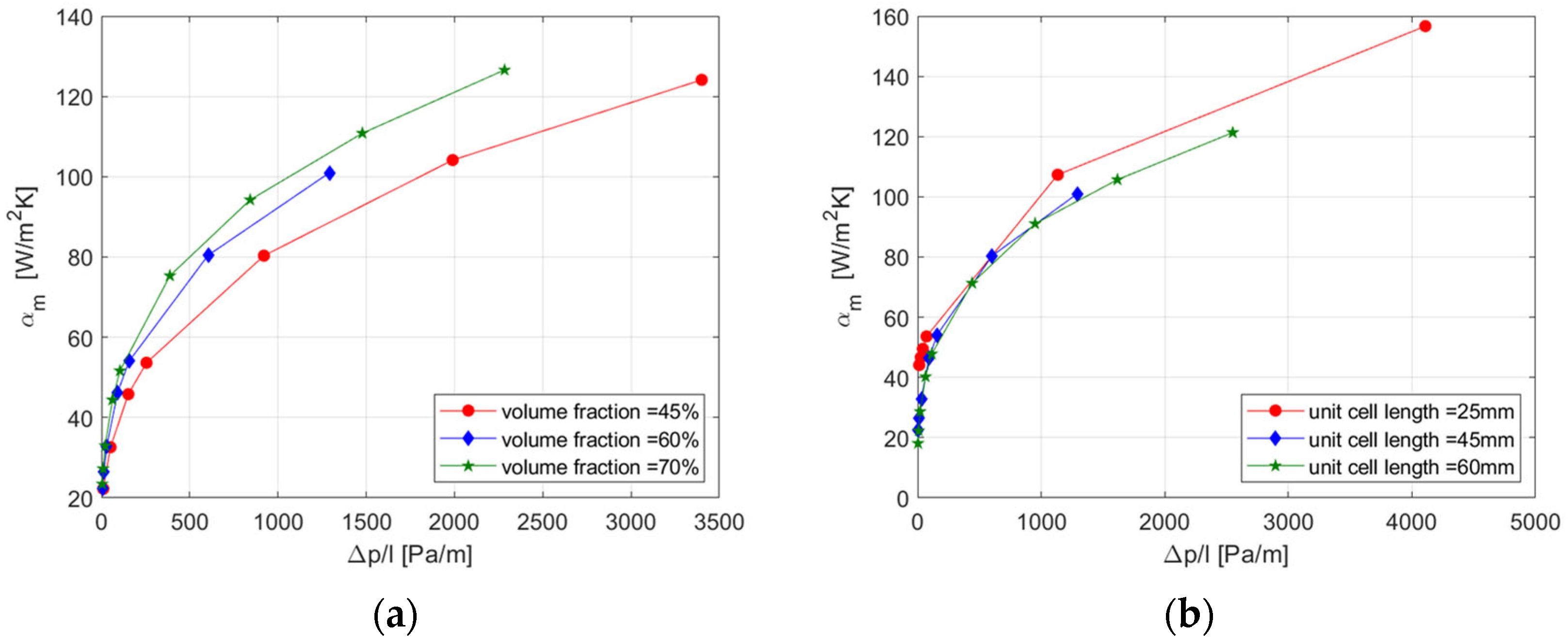
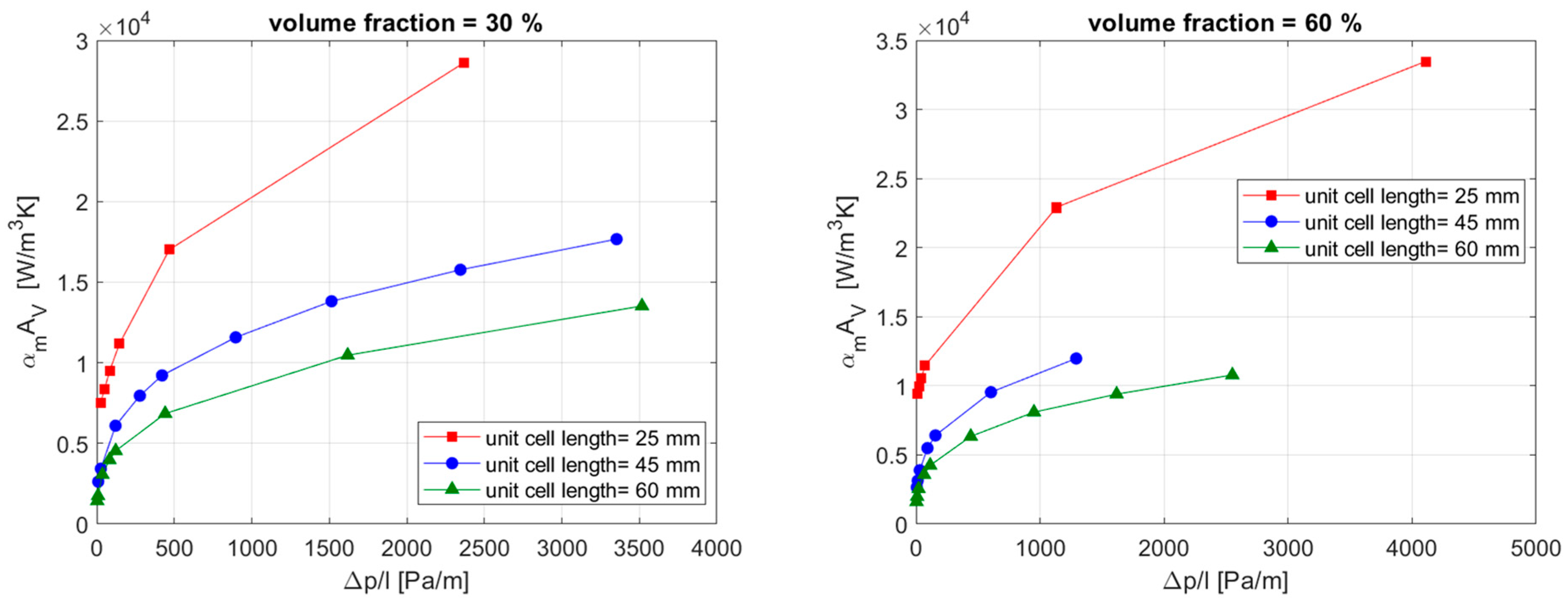

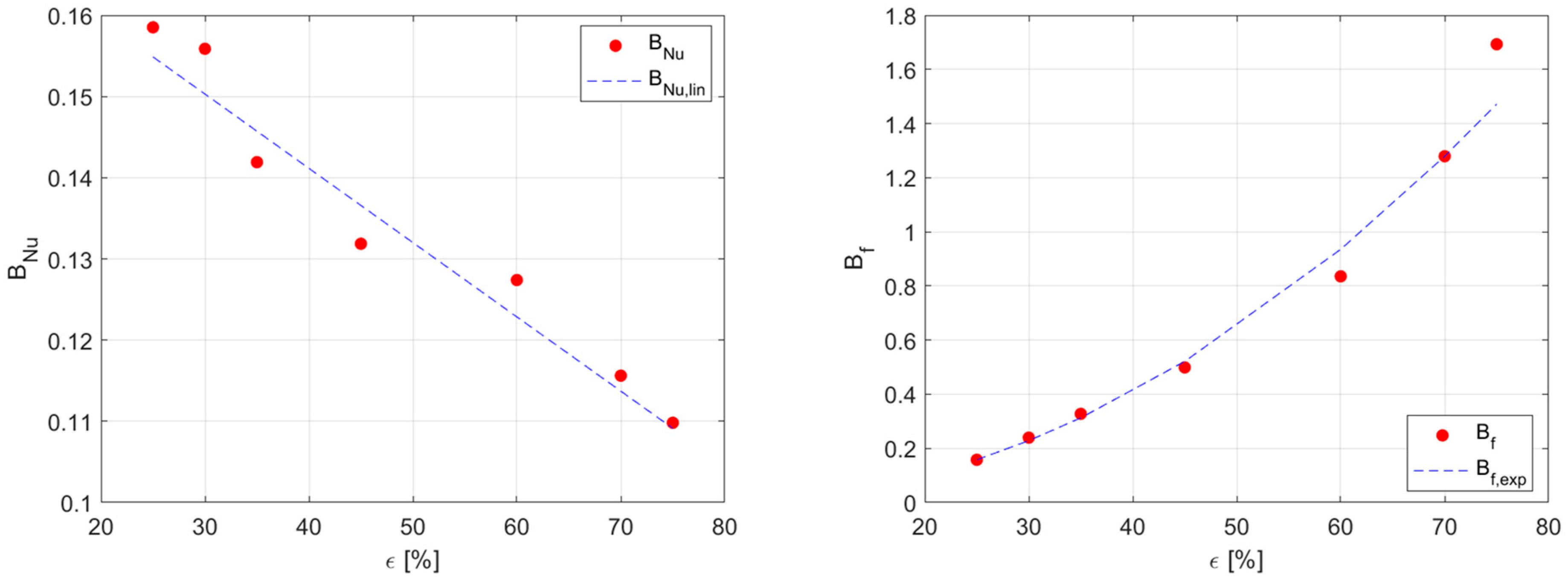
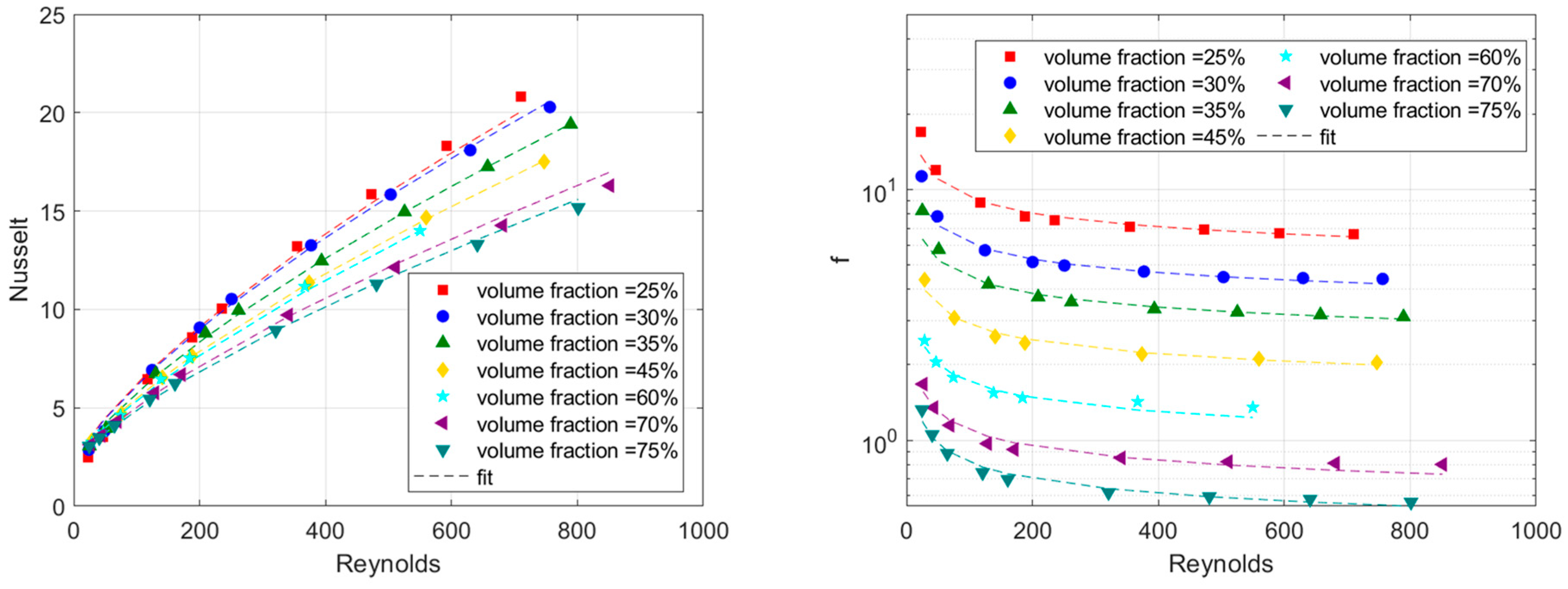

| Volume Fraction [%] | Inlet Velocity vinlet [m/s] | |||||||
|---|---|---|---|---|---|---|---|---|
| 0.3 | 0.8 | 1.5 | 2 | 4 | 6 | 8 | 10 | |
| Mass Flow [kg/s] | ||||||||
| 45 | 1.21 × 10−4 | 3.23 × 10−4 | 6.06 × 10−4 | 8.08 × 10−4 | 1.62 × 10−3 | 2.42 × 10−3 | 3.24 × 10−3 | - |
| 60 | 1.48 × 10−4 | 2.47 × 10−4 | 3.96 × 10−4 | 7.42 × 10−4 | 9.90 × 10−4 | 1.98 × 10−3 | - | - |
| 70 | 1.68 × 10−4 | 2.79 × 10−4 | 4.47 × 10−4 | 8.38 × 10−4 | 1.12 × 10−3 | 2.23 × 10−3 | 3.35 × 10−3 | 4.47 × 10−3 |
| 75 | 1.78 × 10−4 | 2.97 × 10−4 | 4.75 × 10−4 | 8.90 × 10−4 | 1.19 × 10−3 | 2.37 × 10−3 | 3.56 × 10−3 | 4.75 × 10−3 |
| Volume Fraction ε [%] | Fit Parameters Nusselt | Fit Parameters Friction Factor | ||||
|---|---|---|---|---|---|---|
| ANu | BNu | CNu | Af | Bf | Cf | |
| 25 | 1.818 | 0.159 | 0.722 | −0.051 | 0.158 | 0.148 |
| 30 | 1.818 | 0.156 | 0.722 | −0.051 | 0.240 | 0.148 |
| 35 | 1.818 | 0.142 | 0.722 | −0.051 | 0.328 | 0.148 |
| 45 | 1.818 | 0.132 | 0.722 | −0.051 | 0.499 | 0.148 |
| 60 | 1.818 | 0.127 | 0.722 | −0.051 | 0.836 | 0.148 |
| 70 | 1.818 | 0.116 | 0.722 | −0.051 | 1.279 | 0.148 |
| 75 | 1.818 | 0.110 | 0.722 | −0.051 | 1.693 | 0.148 |
| Fit Parameters BNu,lin | Fit Parameters Bf,exp | ||
|---|---|---|---|
| mNu | kNu | mf | kf |
| −0.001 | 0.178 | 2.271 × 10−4 | 2.033 |
Disclaimer/Publisher’s Note: The statements, opinions and data contained in all publications are solely those of the individual author(s) and contributor(s) and not of MDPI and/or the editor(s). MDPI and/or the editor(s) disclaim responsibility for any injury to people or property resulting from any ideas, methods, instructions or products referred to in the content. |
© 2024 by the authors. Licensee MDPI, Basel, Switzerland. This article is an open access article distributed under the terms and conditions of the Creative Commons Attribution (CC BY) license (https://creativecommons.org/licenses/by/4.0/).
Share and Cite
Knödler, P.; Dreissigacker, V. Fluid Dynamic Assessment and Development of Nusselt Correlations for Fischer Koch S Structures. Energies 2024, 17, 688. https://doi.org/10.3390/en17030688
Knödler P, Dreissigacker V. Fluid Dynamic Assessment and Development of Nusselt Correlations for Fischer Koch S Structures. Energies. 2024; 17(3):688. https://doi.org/10.3390/en17030688
Chicago/Turabian StyleKnödler, Philipp, and Volker Dreissigacker. 2024. "Fluid Dynamic Assessment and Development of Nusselt Correlations for Fischer Koch S Structures" Energies 17, no. 3: 688. https://doi.org/10.3390/en17030688




